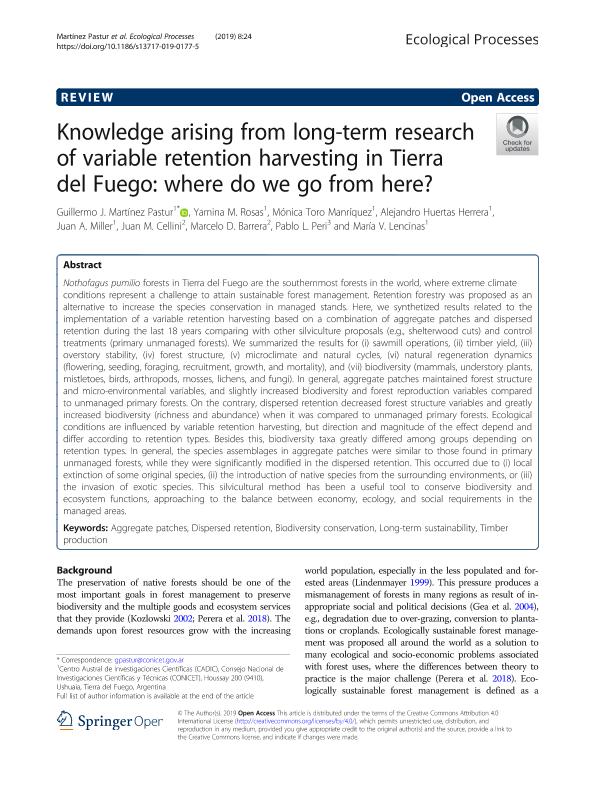Mostrar el registro sencillo del ítem
dc.contributor.author
Martínez Pastur, Guillermo José

dc.contributor.author
Rosas, Yamina Micaela

dc.contributor.author
Toro Manríquez, Mónica del Rosario

dc.contributor.author
Huertas Herrera, Alejandro

dc.contributor.author
Miller, Juan Andrés

dc.contributor.author
Cellini, Juan Manuel

dc.contributor.author
Barrera, Marcelo Daniel

dc.contributor.author
Lencinas, María Vanessa

dc.date.available
2020-10-28T14:48:40Z
dc.date.issued
2019-07
dc.identifier.citation
Martínez Pastur, Guillermo José; Rosas, Yamina Micaela; Toro Manríquez, Mónica del Rosario; Huertas Herrera, Alejandro; Miller, Juan Andrés; et al.; Knowledge arising from long-term research of variable retention harvesting in Tierra del Fuego: where do we go from here?; Springer; Ecological Processes; 8; 1; 7-2019; 24-24
dc.identifier.issn
2192-1709
dc.identifier.uri
http://hdl.handle.net/11336/117051
dc.description.abstract
Nothofagus pumilio forests in Tierra del Fuego are the southernmost forests in the world, where extreme climate conditions represent a challenge to attain sustainable forest management. Retention forestry was proposed as an alternative to increase the species conservation in managed stands. Here, we synthetized results related to the implementation of a variable retention harvesting based on a combination of aggregate patches and dispersed retention during the last 18 years comparing with other silviculture proposals (e.g., shelterwood cuts) and control treatments (primary unmanaged forests). We summarized the results for (i) sawmill operations, (ii) timber yield, (iii) overstory stability, (iv) forest structure, (v) microclimate and natural cycles, (vi) natural regeneration dynamics (flowering, seeding, foraging, recruitment, growth, and mortality), and (vii) biodiversity (mammals, understory plants, mistletoes, birds, arthropods, mosses, lichens, and fungi). In general, aggregate patches maintained forest structure and micro-environmental variables, and slightly increased biodiversity and forest reproduction variables compared to unmanaged primary forests. On the contrary, dispersed retention decreased forest structure variables and greatly increased biodiversity (richness and abundance) when it was compared to unmanaged primary forests. Ecological conditions are influenced by variable retention harvesting, but direction and magnitude of the effect depend and differ according to retention types. Besides this, biodiversity taxa greatly differed among groups depending on retention types. In general, the species assemblages in aggregate patches were similar to those found in primary unmanaged forests, while they were significantly modified in the dispersed retention. This occurred due to (i) local extinction of some original species, (ii) the introduction of native species from the surrounding environments, or (iii) the invasion of exotic species. This silvicultural method has been a useful tool to conserve biodiversity and ecosystem functions, approaching to the balance between economy, ecology, and social requirements in the managed areas.
dc.format
application/pdf
dc.language.iso
eng
dc.publisher
Springer

dc.rights
info:eu-repo/semantics/openAccess
dc.rights.uri
https://creativecommons.org/licenses/by/2.5/ar/
dc.subject
AGGREGATE PATCHES
dc.subject
BIODIVERSITY CONSERVATION
dc.subject
DISPERSED RETENTION
dc.subject
LONG-TERM SUSTAINABILITY
dc.subject
TIMBER PRODUCTION
dc.subject.classification
Silvicultura

dc.subject.classification
Agricultura, Silvicultura y Pesca

dc.subject.classification
CIENCIAS AGRÍCOLAS

dc.title
Knowledge arising from long-term research of variable retention harvesting in Tierra del Fuego: where do we go from here?
dc.type
info:eu-repo/semantics/article
dc.type
info:ar-repo/semantics/artículo
dc.type
info:eu-repo/semantics/publishedVersion
dc.date.updated
2020-04-24T17:51:31Z
dc.journal.volume
8
dc.journal.number
1
dc.journal.pagination
24-24
dc.journal.pais
Países Bajos

dc.journal.ciudad
Amsterdam
dc.description.fil
Fil: Martínez Pastur, Guillermo José. Consejo Nacional de Investigaciones Científicas y Técnicas. Centro Austral de Investigaciones Científicas; Argentina
dc.description.fil
Fil: Rosas, Yamina Micaela. Consejo Nacional de Investigaciones Científicas y Técnicas. Centro Austral de Investigaciones Científicas; Argentina
dc.description.fil
Fil: Toro Manríquez, Mónica del Rosario. Consejo Nacional de Investigaciones Científicas y Técnicas. Centro Austral de Investigaciones Científicas; Argentina
dc.description.fil
Fil: Huertas Herrera, Alejandro. Consejo Nacional de Investigaciones Científicas y Técnicas. Centro Austral de Investigaciones Científicas; Argentina
dc.description.fil
Fil: Miller, Juan Andrés. Consejo Nacional de Investigaciones Científicas y Técnicas. Centro Austral de Investigaciones Científicas; Argentina
dc.description.fil
Fil: Cellini, Juan Manuel. Universidad Nacional de La Plata; Argentina. Consejo Nacional de Investigaciones Científicas y Técnicas; Argentina
dc.description.fil
Fil: Barrera, Marcelo Daniel. Universidad Nacional de La Plata; Argentina
dc.description.fil
Fil: Lencinas, María Vanessa. Consejo Nacional de Investigaciones Científicas y Técnicas. Centro Austral de Investigaciones Científicas; Argentina
dc.journal.title
Ecological Processes
dc.relation.alternativeid
info:eu-repo/semantics/altIdentifier/url/https://ecologicalprocesses.springeropen.com/articles/10.1186/s13717-019-0177-5
dc.relation.alternativeid
info:eu-repo/semantics/altIdentifier/doi/https://doi.org/10.1186/s13717-019-0177-5
Archivos asociados
